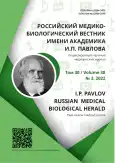Изучение электрофизиологических свойств атриовентрикулярного узла в условиях постоянной электрокардиостимуляции под влиянием триметазидина дигидрохлорида
- Авторы: Смирнов В.Н.1, Староверов И.Н.1, Гридин А.Н.1
-
Учреждения:
- Областная клиническая больница
- Выпуск: Том 30, № 3 (2022)
- Страницы: 305-312
- Раздел: Оригинальные исследования
- URL: https://journals.rcsi.science/pavlovj/article/view/104696
- DOI: https://doi.org/10.17816/PAVLOVJ104696
- ID: 104696
Цитировать
Аннотация
Введение. Двухкамерная электрокардиостимуляция (ЭКС) позволяет сохранить постоянную предсердно-желудочковую синхронизацию. Осуществляется физиологическая последовательность распространения импульса от предсердий к желудочкам с наличием искусственного интервала задержки по аналогии с задержкой распространения возбуждения по атриовентрикулярному (АВ) узлу здорового человека. Интервал задержки формируется таким образом, чтобы минимизировать правожелудочковую стимуляцию. Это сохраняет фракцию выброса левого желудочка, снижает риск развития хронической сердечной недостаточности (ХСН), увеличивает функциональные возможности пациента и снижает риск развития фибрилляции предсердий. С другой стороны, предельное увеличение атриовентрикулярной задержки ведет к развитию пейсмекерного синдрома: ухудшается функция кровообращения, наблюдается одышка, недостаточная толерантность к физической нагрузке, головокружение, синкопальные состояния. Остается до конца неразрешённым вопрос о влиянии постоянной ЭКС на проводимость АВ узла.
Цель. Изучить влияние триметазидина дигидрохлорида на проводимость АВ узла в условиях постоянной ЭКС, определить влияние ЭКС на АВ узел в исследуемый временной период.
Материалы и методы. В исследование включено 86 пациентов. Проведена оценка активности АВ узла путем определения точки Венкебаха антеградно интраоперационно по данным электрокардиограммы, через 24–48 ч после имплантации электрокардиостимулятора, через 6–8 часов, через 7, 14, 21, 90 и 180 дней после приема препарата триметазидина дигидрохлорида и через 7, 14, 21 и 30 дней после его отмены. Для сравнения степени влияния изучаемого препарата на активность АВ узла в зависимости от основной патологии исследуемые пациенты были разделены на три группы: группа 1 ― пациенты с синдромом слабости синусового узла (n = 38, 44,2%); группа 2 ― пациенты с АВ блокадой 2 степени (n = 25, 29,1%); группа 3 ― пациенты с АВ блокадой 3 степени (n = 23, 26,7%).
Результаты. Триметазидина дигидрохлорид улучшает электрофизиологические свойства АВ узла в первой и второй группе исследуемых больных: прибавка в среднем значении точки Венкебаха антеградно в сумме в первой группе составила 3,26% (р = 0,022), во второй группе ― 4,68% (р = 0,001). У третей группы пациентов улучшений не отмечено, но стоит указать, что под действием исследуемого препарата на фоне АВ блокады 3 степени у 4-х пациентов из 23 появилось антеградное АВ проведение (р = 0,236).
Заключение. Назначение триметазидина дигидрохлорида оказывает положительное влияние на активность АВ узла уже через 6–8 ч после приема, а своего максимального эффекта препарат достигает спустя 3 недели. ЭКС не оказывала влияние на АВ узел в течение периода наблюдения (6 месяцев).
Полный текст
Открыть статью на сайте журналаОб авторах
Василий Николаевич Смирнов
Областная клиническая больница
Автор, ответственный за переписку.
Email: osiber82@gmail.com
ORCID iD: 0000-0002-3314-0486
SPIN-код: 7833-8567
Россия, Ярославль
Илья Николаевич Староверов
Областная клиническая больница
Email: istaroverov@mail.ru
ORCID iD: 0000-0001-9855-9467
SPIN-код: 8011-7176
ResearcherId: М-8174-2014
д.м.н., профессор
Россия, ЯрославльАлександр Николаевич Гридин
Областная клиническая больница
Email: angrin61@yandex.ru
ORCID iD: 0000-0002-5087-7463
к.м.н.
Россия, ЯрославльСписок литературы
- Симоненко В.Б., Стеклов В.И. Электрическая стимуляция сердца: история, современное состояние и перспектива развития // Клиническая медицина. 2012. № 12. С. 4–10.
- Lamas G.A., Lee K., Sweeney M., et al. The Mode Selection Trial (MOST) in sinus node dysfunction: design, rationale, and baseline characteristics of the first 1000 patients // American Heart Journal. 2000. Vol. 140, № 4. P. 541–551. doi: 10.1067/mhj.2000.109652
- Ардашев В.Н., Ардашев А.В., Стеклов В.И. Лечение нарушений сердечного ритма. 2-е изд. М.: Медпрактика-М; 2005.
- Ревишвили А.Ш., ред. Временная электрокардиостимуляция. Руководство. М.: ГЭОТАР-Медиа; 2009.
- Ревишвили А.Ш., ред. Постоянная электрокардиостимуляция и дефибрилляция в клинической практике. М.: Медпрактика-М; 2007.
- Ревишвили А.Ш., Артюхина Е.А., Глезер М.Г., и др. Брадиаритмии и нарушения проводимости. Клинические рекомендации 2020 // Российский кардиологический журнал. 2021. Т. 26, № 4. Р. 203–245. doi: 10.15829/1560-4071-2021-4448
- Бокерия О.Л., Сергеев А.В. Современное состояние проблемы однокамерной предсердной и двухкамерной электрокардиостимуляции у пациентов с синдромом слабости синусного узла // Анналы аритмологии. 2012. № 3. C. 13–21.
- Бокерия Л.А., Ревишвили А.Ш., Дубровский И.А. Состояние электрокардиостимуляции в России в 2010 году // Вестник аритмологии. 2012. № 68. Р. 77–80.
- Абдульянов И.В., Вагизов И.И. Современные подходы к постоянной электрокардиостимуляции // Практическая медицина. 2013. № 3 (71). C. 49–55.
- Санакоева В.А., Рыбаченко М.С., Пухаева А.А., и др. Биомеханика миокарда, внутрисердечная гемодинамика и эндотелиальная функция у пациентов до и после имплантации различных типов электрокардиостимуляторов // CardioСоматика. 2019. Т. 10, № 2. C. 56–64. doi: 10.26442.22217185.2.190307
- Steinberg J.S., Fischer A., Wang P., et al. The clinical implications of cumulative right ventricular pacing in the multicenter automatic defibrillator trial II // Journal of Cardiovascular Electrophysiology. 2005. Vol. 16, № 4. P. 359–365. doi: 10.1046/j.1540-8167.2005.50038.x
Дополнительные файлы







